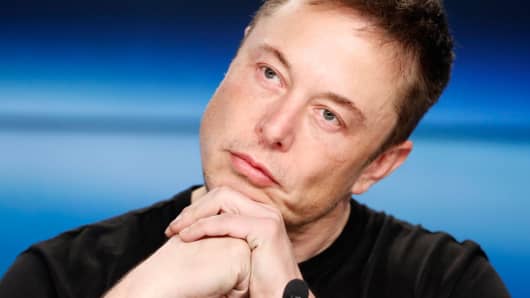The all-new Roadster will be able to travel 620 miles (1000 km) on a single charge, a new record for an electric vehicle
The first 1,000 of the new Roadsters will cost $250,000 (£190,000) each, paid in full up front, with later models starting at $200,000 (£150,000). It will be available in 2020, Tesla claims
During a recent shareholders meeting, Elon Musk revealed plans to reduce charge times at Tesla Supercharger stations, promising three- or four-fold improvement for newer vehicles, like the upcoming Roadster
Powering the car is a 200 kilowatt hour battery pack. Musk claims drivers will be able to drive from LA to San Francisco, and back, at highway speed without recharging. Pictured: The futuristic steering wheel for the 2020 Tesla Roadster
The all-new Roadster can travel 620 miles (1,000 km) on a single charge – a new record for an all-electric vehicle.
The Roadster can go from 0 to 60 miles per hour (0 to 100 km/h) in 1.9 seconds and boasts a top speed over 250mph (400 kph).
This would make it the quickest electric car ever sold to the public, beating the Chinese-made NIO EP9 all-electric hypercar, which has a top speed of 194 mph (310 kph).
It also makes the vehicle the fastest production car ever, with a 0 to 60 miles per hour acceleration quicker than any non-electric vehicles, including the record-breaking Bugatti Chiron, released this year.
It’s unclear whether the Roadster’s top speed was achieved using the so-called Space X option, or whether the rocket-assisted version of the vehicle will be even faster.
'You’ll be able to travel from LA to San Francisco, and back, at highway speed without recharging,' Elon Musk said during the launch event last November.
‘These numbers sound nutty, but they’re real. The point of doing this is to just give a hardcore smackdown to gasoline cars.
'Driving a gasoline sports car is going to feel like a steam engine with a side of quiche.'
The first 1,000 cars will cost $250,000 (£190,000) each, paid in full up front, with later models starting at $200,000 (£150,000).
It will be available to buy in 2020.
Powering the Tesla Roadster will be a 200 kilowatt hour battery pack.
WHAT ARE THE TOP FIVE FASTEST PRODUCTION ELECTRIC CARS IN THE WORLD?
The electric supercar market has ramped up in recent years, with several companies - many of them small startups - vying to build the quickest.
Electric cars have rapid acceleration largely because combustion engines cannot produce immediate torque, while electric engines can.
This means that many of the world's fastest production electric cars, which are road legal, accelerate faster than most Formula One vehicles.
Here are the top five fastest production electric cars.
1) Rimac Concept Two: 0-60mph (0-100kph) in 1.85 seconds
2) Tesla's next generation Roadster: 0-60 in 1.9 seconds
3) Aspark Owl: 0-60 in 1.921 seconds
4) Faraday Future FF 91: 0-60 in 2.39 seconds
5) Tesla Model S P100D: 0-60 in 2.4 seconds
The first 1,000 of the new Roadsters will cost $250,000 (£190,000) each, paid in full up front, with later models starting at $200,000 (£150,000). It will be available in 2020, Tesla claims
During a recent shareholders meeting, Elon Musk revealed plans to reduce charge times at Tesla Supercharger stations, promising three- or four-fold improvement for newer vehicles, like the upcoming Roadster
Powering the car is a 200 kilowatt hour battery pack. Musk claims drivers will be able to drive from LA to San Francisco, and back, at highway speed without recharging. Pictured: The futuristic steering wheel for the 2020 Tesla Roadster
The all-new Roadster can travel 620 miles (1,000 km) on a single charge – a new record for an all-electric vehicle.
The Roadster can go from 0 to 60 miles per hour (0 to 100 km/h) in 1.9 seconds and boasts a top speed over 250mph (400 kph).
This would make it the quickest electric car ever sold to the public, beating the Chinese-made NIO EP9 all-electric hypercar, which has a top speed of 194 mph (310 kph).
It also makes the vehicle the fastest production car ever, with a 0 to 60 miles per hour acceleration quicker than any non-electric vehicles, including the record-breaking Bugatti Chiron, released this year.
It’s unclear whether the Roadster’s top speed was achieved using the so-called Space X option, or whether the rocket-assisted version of the vehicle will be even faster.
'You’ll be able to travel from LA to San Francisco, and back, at highway speed without recharging,' Elon Musk said during the launch event last November.
‘These numbers sound nutty, but they’re real. The point of doing this is to just give a hardcore smackdown to gasoline cars.
'Driving a gasoline sports car is going to feel like a steam engine with a side of quiche.'
The first 1,000 cars will cost $250,000 (£190,000) each, paid in full up front, with later models starting at $200,000 (£150,000).
It will be available to buy in 2020.
Powering the Tesla Roadster will be a 200 kilowatt hour battery pack.
WHAT ARE THE TOP FIVE FASTEST PRODUCTION ELECTRIC CARS IN THE WORLD?
The electric supercar market has ramped up in recent years, with several companies - many of them small startups - vying to build the quickest.
Electric cars have rapid acceleration largely because combustion engines cannot produce immediate torque, while electric engines can.
This means that many of the world's fastest production electric cars, which are road legal, accelerate faster than most Formula One vehicles.
Here are the top five fastest production electric cars.
1) Rimac Concept Two: 0-60mph (0-100kph) in 1.85 seconds
2) Tesla's next generation Roadster: 0-60 in 1.9 seconds
3) Aspark Owl: 0-60 in 1.921 seconds
4) Faraday Future FF 91: 0-60 in 2.39 seconds
5) Tesla Model S P100D: 0-60 in 2.4 seconds












